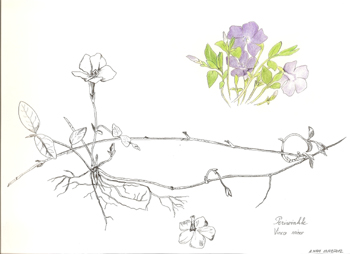A word about plant morphology
Students have different goals for this course. Some are interested in mastering one or two media; others are intrigued with exposure to a diversity of media, hoping to gain proficiency in each. Some find a painterly approach to be very compelling, while others are dedicated to a scientific exploration that deepens their understanding of plant morphology, wanting to know how to accurately portray plants, and present material from a robust, scholarly perspective.
If you fall into the latter group, there is an additional recommended resource for you. In fact, I would like to recommend it to everyone, and yet, I hesitate, since you have already made a significant investment in materials. Since it is a text book, it is rather expensive, in the $30 range. And yet, if you are dedicated to this path, it will be immensely helpful to you. The illustrations are outstanding.
The book is Plant Form: an Illustrated Guide to Flowering Plant Morphology, by Adrian Bell with drawings by Alan Bryan. Timber Press, 2008.
Description:
"The diverse external shapes and structures that make up flowering plants can be bewildering and even daunting, as can the terminology used to describe them. An understanding of plant form - plant morphology - is essential to appreciating the wonders of the plant world and to the study of botany and horticulture at every level. In this ingeniously designed volume, the complex subject becomes both accessible and manageable. The first part of the book describes and clearly illustrates the major plant structures that can be seen with the naked eye or a hand lens: leaf, root, stem, reproductive organs, and seedlings; special sections focus on vegetative propagation, and the morphology of grasses, orchids, and cacti. However, plants are dynamic organisms, constantly growing, changing, and becoming more elaborate, and understanding the development of a plant or plant part is as important as describing its final form. Part II focuses on how plants grow: bud development, the growth of reproductive organs, leaf arrangement, branching patterns, and the accumulation and loss of structures. This classic book, now revised and expanded to include the latest information on plant morphology, more than 1000 exquisite line drawings including 119 that are new to this edition, and nearly twice as many photographs as the previous edition, is remarkable for its user-friendly organization, high-quality illustrations, and extensive cross-referencing. Aimed at students of botany and horticulture, enthusiastic gardeners and amateur naturalists, it functions as an illustrated dictionary, a basic course in plant morphology, and an intriguing and enlightening book to dip into."
